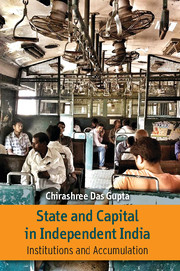Book contents
- Frontmatter
- Dedication
- Contents
- Figures
- Tables
- Acknowledgements
- 1 Introduction
- 2 Globalization and Neoliberalism: The Context and the Debate
- 3 State and Capital in Independent India: The Problematic
- 4 Policy Regimes and Macroeconomic Outcomes: 1947–1966
- 5 Institutionalization of the Regime of Capital in India: 1947–1966
- 6 Continuity and Change in Capital Accumulation: 1966–1980
- 7 Sources of Accumulation: State Intervention and Non-intervention
- 8 ‘Old Oligopolies and New Entrants’ in the Pharmaceutical Sector
- 9 Conclusion
- Bibliography
- Index
6 - Continuity and Change in Capital Accumulation: 1966–1980
Published online by Cambridge University Press: 05 September 2016
- Frontmatter
- Dedication
- Contents
- Figures
- Tables
- Acknowledgements
- 1 Introduction
- 2 Globalization and Neoliberalism: The Context and the Debate
- 3 State and Capital in Independent India: The Problematic
- 4 Policy Regimes and Macroeconomic Outcomes: 1947–1966
- 5 Institutionalization of the Regime of Capital in India: 1947–1966
- 6 Continuity and Change in Capital Accumulation: 1966–1980
- 7 Sources of Accumulation: State Intervention and Non-intervention
- 8 ‘Old Oligopolies and New Entrants’ in the Pharmaceutical Sector
- 9 Conclusion
- Bibliography
- Index
Summary
This chapter looks at the sectoral nature of accumulation and growth since the balance of payment crisis in 1965–66 till the liberalization policies of the 1980s. It traces continuities and change in the accumulation process in the period under consideration as compared with the first two decades after independence.
The period from 1965 to 1980 has been the subject of an impressive amount of academic literature (Chakravarty, 1987; Patnaik, 1994; Nayyar, 1996). The literature that addresses the period of acknowledged recession in Indian manufacturing from 1965–66 has discussed a wide array of factors. The sources of constraints on the investment ratio, the limits of import-substituting industrialization (ISI) in the Indian context due to the inability of the state to ‘discipline’ capitalists, the inability of indicative planning to ensure a balanced distribution of investment and resources and the merits of India's growth performance in a comparative perspective have been analyzed in detail. Numerous studies have debated the cause of the recession that set in from the mid-1960s. The short-term analyses of the slow-down in growth attribute it to the wars of 1962, 1965 and 1971, which diverted potential public investment into unproductive uses and the successive droughts of 1965–66 to 1966–67, and later 1970–71 to 1972–73, which restricted the supply of raw materials and the demand for industrial goods from the agricultural sector (Government of India, 1969). However, longer-term analysis with the benefit of hindsight has stressed that these factors could not account for the persistence of stagnation long after the disappearance of the short-term problems (Shetty, 1994; Nayyar, 1996). The literature addressing the long structural retrogression since the mid 1960s in the Indian economy have focussed on the stagnation in the demand for important mass consumer goods, the stagnation in the demand for elementary producer goods leading to a crisis in engineering production, the fall in public investment, the fall in agricultural output and an adverse movement in the terms of trade of industry against agriculture, which had impact on profits through enhanced wage costs in the industrial sector (Bagchi, 1998).
Sifting through this literature, it becomes apparent that the state in this period continued to be a terrain of contest for the dominant classes and class factions with diverging interests and uneasy relationships. There were significant changes in the realm of state–society relations since 1966.
- Type
- Chapter
- Information
- State and Capital in Independent IndiaInstitutions and Accumulations, pp. 142 - 176Publisher: Cambridge University PressPrint publication year: 2016



